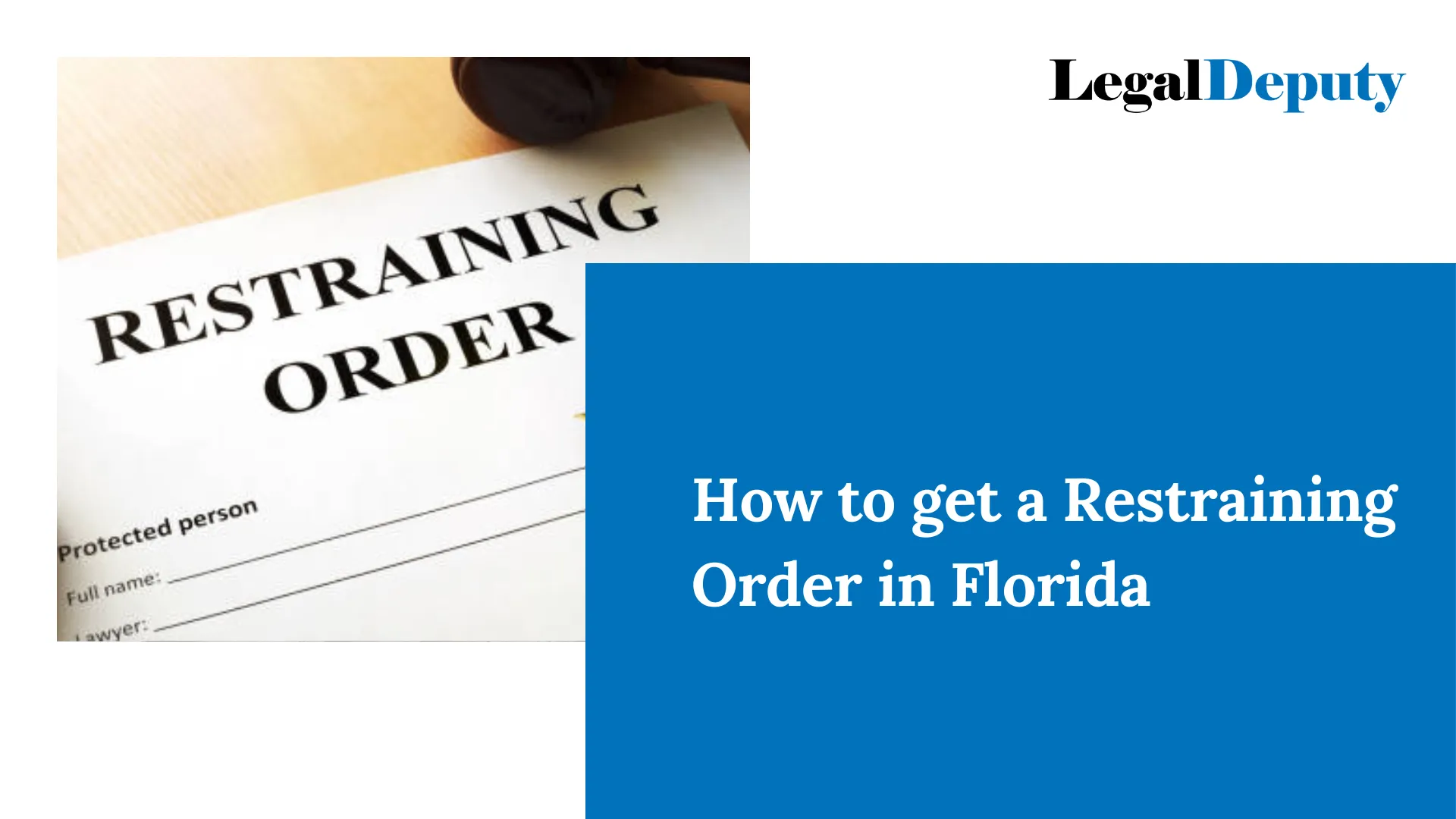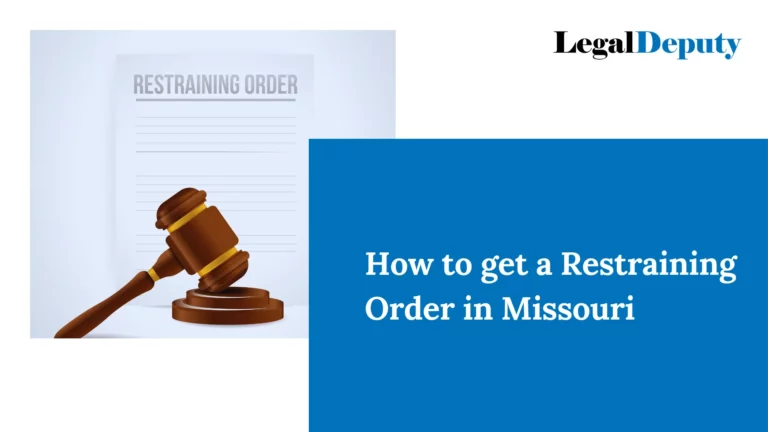How to get a Restraining Order in Florida in 2024 – All You Need To Know
In a world where personal safety is paramount, understanding the legal mechanisms that can protect you is crucial. Restraining orders, often the first line of defense against harassment and threats, play a vital role in safeguarding individuals in Florida.
Whether you’re facing a challenging situation or wish to preemptively protect yourself or a loved one, comprehending the process of obtaining a restraining order is the initial step toward regaining peace of mind.

This guide will walk you through the intricacies of securing a restraining order in the Sunshine State, empowering you with the knowledge needed to navigate a difficult situation effectively. Let’s embark on this journey towards safety and security in the state of Florida.
Understanding Restraining Orders in Florida
A restraining order, also known as an injunction for protection, is a legal document issued by a court that provides a level of legal protection to individuals who have experienced harassment, violence, or threats from another party. Its primary purpose is to create a safe buffer between the victim and the alleged abuser, ensuring that the victim can go about their daily life without fear or interference.
Types of Restraining Orders in Florida:
In Florida, there are several types of restraining orders, each tailored to specific situations and relationships. These include:
Domestic Violence Injunction: This type of restraining order is designed to protect victims of domestic violence, including spouses, former spouses, individuals living together as a family, and those related by blood or marriage.
Dating Violence Injunction: Geared towards protecting individuals who are or were involved in a dating relationship, this injunction addresses situations where one party has been a victim of dating violence.
Repeat Violence Injunction: When an individual has been a victim of two or more incidents of violence or stalking, a repeat violence injunction can be sought to provide protection.
Sexual Violence Injunction: Victims of sexual violence can apply for this type of injunction, specifically addressing the circumstances related to sexual assault or abuse.
Stalking Injunction: For those who have experienced a pattern of stalking behavior, a stalking injunction is available to safeguard them from further harassment.
Understanding the different types of restraining orders in Florida is vital, as it ensures that individuals can seek the most appropriate legal protection based on their unique circumstances. These legal safeguards serve to humanize the often complex and intimidating legal process, providing much-needed security and peace of mind for those who need it most.
Eligibility and Grounds
Who Can Apply for a Restraining Order in Florida:
In Florida, the legal system is designed to be inclusive, allowing various individuals to seek protection through restraining orders. Eligibility is not confined to one specific category, and those who can apply include:
Victims of Domestic Violence: This category encompasses spouses, former spouses, individuals residing together as a family, individuals related by blood or marriage, and individuals who have a child in common, making it clear that domestic violence victims have the legal right to seek protection.
Dating Violence Victims: If you’re currently or were previously involved in a dating relationship and have been subjected to dating violence, you are eligible to seek a restraining order in Florida.
Repeat Violence Victims: Those who have experienced two or more incidents of violence or stalking can seek protection through a repeat violence injunction.
Sexual Violence Victims: Victims of sexual violence, including sexual assault and abuse, can apply for a sexual violence injunction to safeguard their well-being.
Stalking Victims: If you have been the target of persistent stalking behavior, you are eligible to seek a stalking injunction to protect yourself from further harassment.
Grounds for Seeking a Restraining Order:
The legal grounds for seeking a restraining order in Florida are primarily based on concerns related to safety and protection from harm. Valid reasons for seeking such protection may include:
Domestic Violence: This includes physical, emotional, or psychological abuse within a domestic setting, and it extends to various relationships, ensuring that victims are not confined to a specific definition.
Dating Violence: Individuals involved in a dating relationship may seek protection when they have experienced dating violence, which can encompass physical, emotional, or psychological abuse within that context.
Repeat Violence: Victims who have faced repeated acts of violence or stalking are eligible for a restraining order, recognizing the danger inherent in these recurring situations.
Sexual Violence: Victims of sexual violence, including sexual assault and abuse, can seek an injunction to prevent further trauma and danger.
Stalking: Those targeted by persistent stalking behavior can obtain an injunction, addressing the very real fear and discomfort that accompanies such harassment.
Understanding who is eligible for a restraining order and the valid grounds for seeking one is essential. This knowledge empowers individuals to take the necessary steps to protect themselves from harm while humanizing the legal process by recognizing the diverse range of people it aims to assist. By addressing these concerns, the legal system in Florida stands as a pillar of support for those in need of protection.
Preparing for the Process
Embarking on the journey to obtain a restraining order in Florida is a significant step toward personal safety and well-being. One of the key elements that can make this process smoother and more effective is proper preparation. It’s not just a legal formality; it’s a crucial step that can enhance your chances of a successful outcome while ensuring your safety is the top priority.
Gathering Evidence and Documentation:
When seeking a restraining order, it’s vital to gather as much evidence and documentation as possible. This evidence can include:
Incident Reports: Document each incident of abuse, violence, or harassment. Include dates, times, locations, and descriptions of what occurred. Be as specific as possible, as these reports are essential for building your case.
Witness Statements: If there were witnesses to any incidents, ask them to provide statements that can corroborate your claims. Their testimony can significantly strengthen your case.
Photographic or Video Evidence: If you have visible injuries or damage resulting from the incidents, take photographs or videos. These visual records can be compelling pieces of evidence.
Communications: Save any relevant text messages, emails, or social media messages that demonstrate threats or harassment. These digital communications can be invaluable in court.
Creating a Safety Plan:
While going through the process of obtaining a restraining order, it’s essential to prioritize your safety. Here’s how to create a safety plan:
Stay Informed: Understand the terms of the restraining order, including prohibited contact or proximity. Make sure you know what the order allows and disallows.
Inform Trusted Individuals: Share your safety plan with trusted friends, family members, or colleagues. They can provide support and assistance if needed.
Change Locks or Relocate: If necessary, change locks on doors, install security systems, or consider relocating to a safer location. Make your physical surroundings as secure as possible.
Keep Important Documents Handy: Have a copy of the restraining order, identification, and any other essential documents readily accessible. You may need these in emergency situations.
Establish a Code Word: Create a code word to use with trusted individuals to signal that you’re in danger or need immediate assistance.
Seek Professional Help: If you feel overwhelmed or in danger, consult with a therapist, counselor, or a support group. Emotional well-being is a crucial component of your safety plan.
Preparation is your shield as you navigate the process of obtaining a restraining order. The evidence and documentation you gather, coupled with a well-thought-out safety plan, not only strengthen your case but also ensure that you’re taking every possible step to protect yourself. Remember, you’re not alone in this journey, and support is available to help you through it.
Filing for a Restraining Order in Florida
When you’ve made the decision to seek a restraining order in Florida, the next crucial step is the actual filing process. Here’s a step-by-step guide to help you through it:
Step 1: Obtain the Necessary Forms
To initiate the process, you need to obtain the appropriate forms. You can find these forms at your local county courthouse or online through the Florida Courts website. Ensure that you select the right form based on the type of restraining order you’re seeking, whether it’s for domestic violence, dating violence, repeat violence, sexual violence, or stalking.
Step 2: Complete the Forms
Carefully fill out the forms, providing accurate and detailed information about your situation, the incidents that have occurred, and the reasons for seeking a restraining order. If you’re unsure about any part of the form, consult with an attorney or a domestic violence advocate for guidance.
Step 3: Review Your Petition
Before filing, review your completed petition for any errors or missing information. Accuracy is crucial to the success of your application.
Step 4: File the Petition
Once you’ve filled out the forms and reviewed them, take the completed paperwork to the clerk of the circuit court in your county. The clerk’s office will provide you with instructions for filing, and there may be a filing fee, though there are exceptions for some situations.
Step 5: Submit Additional Documents
In addition to the completed forms, you’ll need to provide the clerk with any supporting documents, such as your identification, any incident reports, witness statements, photographs, or other evidence you’ve gathered.
Step 6: Swear to the Truth
You’ll need to swear or affirm that the information you’ve provided is true and accurate. This typically involves signing an affidavit in the presence of a notary public.
Step 7: Receive a Court Date
After filing your petition, the clerk will provide you with a court date for your hearing. Make sure to mark this date on your calendar and prepare for your appearance in court.
It’s essential to remember that filing for a restraining order is a legal process that demands attention to detail and accuracy. Seeking guidance from legal professionals or domestic violence advocates can be incredibly helpful during this phase. By following these steps, you’re taking a significant step towards securing your safety and well-being. You’re not alone in this process, and support is available every step of the way.
Temporary vs. Permanent Restraining Orders
When it comes to restraining orders in Florida, there are two distinct phases: temporary and permanent. Each serves a specific purpose in safeguarding individuals, and it’s crucial to comprehend the differences between them.
Temporary Restraining Order
Purpose: A temporary restraining order, also known as a “temporary injunction,” is typically granted when an individual is in immediate danger or needs protection before a formal hearing can take place.
Duration: These orders are issued on a short-term basis and are generally valid until the scheduled hearing date, which is usually within a few weeks.
Process: To obtain a temporary restraining order, you need to demonstrate that you have reasonable cause to believe you are in imminent danger of violence or harassment. This can involve presenting evidence to the court, such as incident reports, testimony, or other documentation.
Hearing: A hearing is scheduled to evaluate the need for a permanent restraining order. It’s essential to attend this hearing to present your case and provide any additional evidence.
Permanent Restraining Order
Purpose: A permanent restraining order, often referred to as a “permanent injunction,” is intended to provide long-term protection for the victim. It is issued after a formal court hearing and typically extends for a specified period or until the court deems it no longer necessary.
Duration: Permanent restraining orders have a more extended duration, providing ongoing protection against the abuser’s actions.
Process: To obtain a permanent restraining order, you must attend the court hearing for the temporary order. During this hearing, both parties will present their cases, and the judge will make a determination based on the evidence and testimony.
Criteria: The court will consider various factors, including the nature and severity of the incidents, the credibility of witnesses, and the need for ongoing protection when deciding to grant a permanent restraining order.
It’s crucial to understand that the temporary restraining order serves as an initial safety measure, while the permanent restraining order offers more extended protection. If a permanent restraining order is granted, it becomes a crucial tool in providing peace of mind and safety to the victim.
The process emphasizes the need for a fair and thorough examination of the evidence, ensuring that individuals in danger receive the protection they deserve. By navigating these phases, the legal system aims to humanize the often daunting process of obtaining restraining orders in Florida, with the ultimate goal of prioritizing safety and well-being.
Serving the Order
After you’ve successfully obtained a restraining order, the next critical step is serving the order to the respondent. This process is vital to ensure the order’s effectiveness and your continued safety. It’s essential to understand the proper way to serve the order, emphasizing the importance of following legal procedures.
The Importance of Proper Service:
Serving the restraining order is more than a mere formality; it’s a fundamental aspect of ensuring your protection. It provides the respondent with notice of the order’s existence, its terms, and the consequences of violating it. Failure to serve the order correctly can lead to complications, and in some cases, the order may not be legally binding if not served appropriately.
Proper Service Procedure:
Serving a restraining order in Florida typically involves the following steps:
Using a Process Server: The most common and recommended method is to employ a professional process server. These individuals are trained in serving legal documents and are familiar with the legal requirements. They can locate the respondent and deliver the order personally.
Sheriff’s Office: In some cases, you can request the local sheriff’s office to serve the order. They can execute service following the legal guidelines.
Acceptance of Service: The respondent may choose to accept service voluntarily, signing an acknowledgment that they have received the restraining order.
Personal Service: Ideally, personal service is preferred, meaning the order is handed directly to the respondent. It is the most effective way to ensure they are aware of the order’s terms and implications.
Proof of Service: After serving the order, a Proof of Service form should be completed and filed with the court to document the successful service. This record is vital in case the order is violated, as it provides evidence that the respondent was properly notified of its terms.
Serving the restraining order correctly is more than just a legal requirement; it is the linchpin to the order’s effectiveness. By ensuring proper service, you are taking a significant step in maintaining your safety and the integrity of the legal process. It humanizes the legal system by prioritizing your protection, ensuring that the order serves its intended purpose – safeguarding your well-being.
Attending the Hearing
The court hearing for your restraining order is a critical step in ensuring your safety. Understanding what to expect during the hearing and being prepared to present your case effectively is essential. Here’s a guide to help you navigate this phase of the process.
What to Expect at the Hearing:
Formal Setting: The hearing typically takes place in a formal courtroom setting, presided over by a judge. Both you and the respondent will have an opportunity to present your cases.
Evidence and Testimony: Be prepared to present the evidence you’ve gathered, such as incident reports, witness statements, photographs, and other relevant documentation. You may also need to provide testimony about your experiences and why you’re seeking the restraining order.
Cross-Examination: The respondent or their attorney may cross-examine you and your witnesses. Stay calm and composed, answering questions truthfully and to the best of your knowledge.
Legal Counsel: Both parties have the right to legal representation. You may choose to have an attorney present to assist you during the hearing.
Decision by the Judge: After hearing both sides, the judge will make a determination regarding the restraining order. If granted, the judge will specify its terms and duration. If not, the court will explain the reasons for denial.
Tips for Presenting Your Case:
Be Prepared: Thoroughly review your evidence and have it organized and easily accessible. Practice what you plan to say in court to ensure clarity and confidence.
Stay Calm and Composed: Court hearings can be emotionally charged, but it’s essential to maintain composure. Stick to the facts and focus on the purpose of the hearing – your safety.
Dress Professionally: Present yourself professionally in court. Your appearance can help create a positive impression.
Respect the Court’s Rules: Follow all court rules and etiquette. Address the judge as “Your Honor” and be respectful to all parties involved.
Legal Counsel: If you’re unsure about the legal process or your rights, consider consulting with an attorney. They can provide guidance and support during the hearing.
Keep Records: Take notes during the hearing, and keep records of what transpires. This can be helpful if further legal action is necessary.
Your presence at the hearing is a critical step in securing your safety through the legal system. Being well-prepared, presenting your case professionally, and staying composed will increase your chances of obtaining the necessary restraining order. It’s important to remember that the legal process is there to support and protect you, and by engaging in it, you’re taking a proactive step towards ensuring your well-being.
Maintaining and Enforcing the Order
Obtaining a restraining order is a significant step toward personal safety, but it’s essential to understand how to maintain and enforce the order effectively. This section provides insight into the responsibilities of both parties and the process for taking action if the order is violated.
Responsibilities of the Petitioner:
Adhere to the Terms: The petitioner must strictly adhere to the terms of the restraining order. This includes maintaining the required distance from the respondent and refraining from any prohibited contact.
Keep a Copy: Always keep a copy of the restraining order with you. You may need to present it to law enforcement if the order is violated.
Report Violations: If the respondent violates the order, report it to the police immediately. Provide as much detail as possible, including the nature of the violation and any evidence you may have.
Responsibilities of the Respondent:
Respect the Order: The respondent must comply with all the terms specified in the restraining order. This includes refraining from any contact or behavior prohibited by the order.
Attend the Hearing: If the respondent wishes to contest the restraining order or have it modified, they should attend the scheduled court hearing to present their case.
Enforcing the Order:
Report Violations: If the respondent violates the order, contact your local law enforcement agency immediately. Provide them with the details of the violation and any evidence you have, such as photographs, witness statements, or communications.
Document Violations: Keep a record of any violations, including dates, times, locations, and descriptions of the incidents. This documentation can be crucial in any legal proceedings.
Document Violations: Keep a record of any violations, including dates, times, locations, and descriptions of the incidents. This documentation can be crucial in any legal proceedings.
Seek Legal Assistance: If the respondent continues to violate the order, or if you believe your safety is at risk, consult with an attorney or domestic violence advocate to explore legal remedies or modifications to the order.
Maintaining and enforcing a restraining order is essential for ensuring your safety. Both parties have responsibilities under the order, and it’s crucial to take violations seriously and report them promptly. The legal system is designed to support your well-being, and by taking these steps, you’re actively safeguarding your personal safety and dignity.
Conclusion
In the quest for personal safety, understanding how to obtain a restraining order in Florida is paramount. This step-by-step guide has shed light on the process, from understanding the types of restraining orders available to maintaining and enforcing them effectively. It’s vital to remember that restraining orders exist to provide protection and peace of mind for those facing harassment, violence, or threats.
Whether you’re a victim of domestic violence, dating violence, repeat violence, sexual violence, or stalking, the legal system in Florida offers avenues for safeguarding your well-being. The journey toward securing a restraining order is not one you need to undertake alone.
Seek assistance from legal professionals, domestic violence advocates, or supportive friends and family. Be prepared, gather evidence, and maintain composure during the court hearing, knowing that you have the right to a safe and secure future.
Also, feel free to browse through the process of getting a restraining order in other states:
Your safety and peace of mind should always be a priority. If you find yourself in a situation where a restraining order is necessary, do not hesitate to take action. By seeking help and following the legal process, you’re not only humanizing the system but also taking the courageous steps required to protect yourself and regain control over your life. Your safety matters, and there is support available to help you achieve it.
Disclaimer:
The information provided on this blog is intended for general informational purposes only. It is not a substitute for professional legal advice. The authors and creators of this blog are not attorneys, and the content should not be construed as legal counsel or the establishment of an attorney-client relationship.
While we strive to ensure the accuracy and currency of the information presented, laws and regulations may change, and the content may not always reflect the most current legal standards or interpretations. Therefore, readers are encouraged to consult with a qualified legal professional or attorney for advice specific to their individual circumstances.
The use of any information from this blog is at the reader’s discretion, and the authors, creators, and website owners are not liable for any consequences resulting from such use. Any reliance on the information herein is done solely at the reader’s risk. We strongly recommend consulting with a licensed attorney to address any legal concerns or questions you may have.




